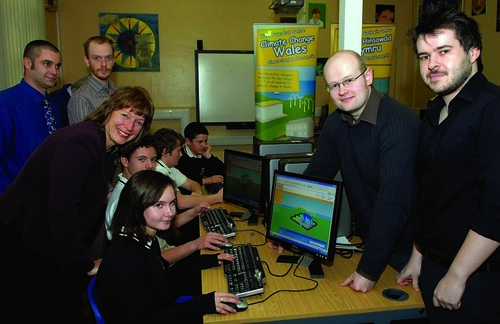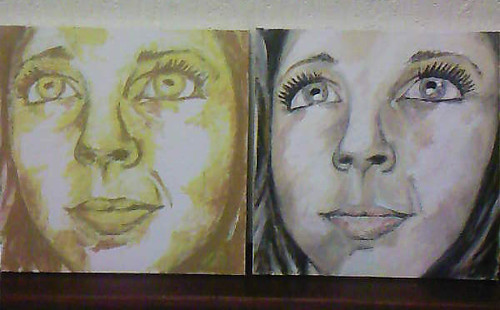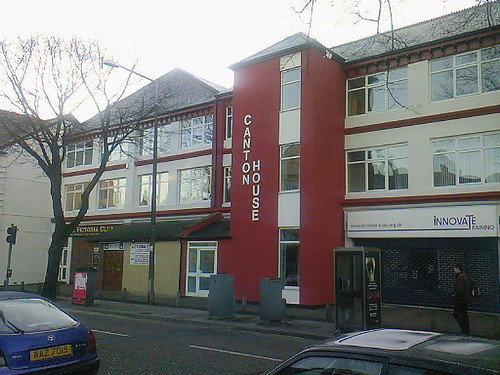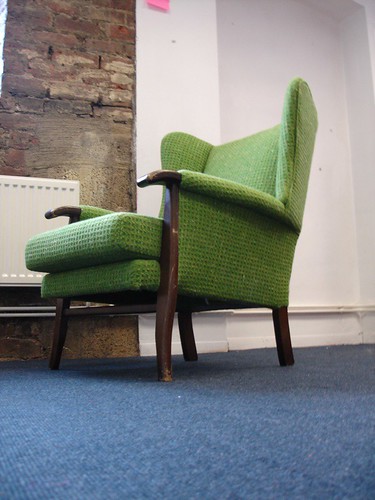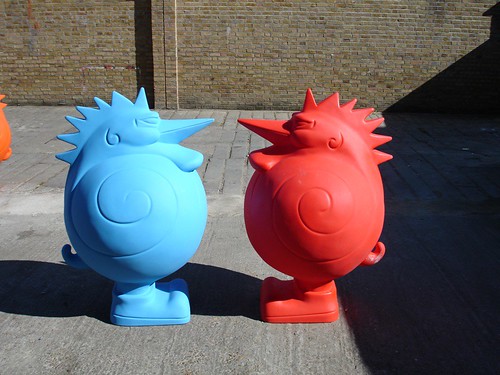Friday 21 December 2007
Christmas greetings
Wednesday 19 December 2007
Climate Change Wales Launch
We have been working with West Wales Eco Centre on a educational climate change website for the last year or so. It was officially launched yesterday at Ysgol Dewi Sant, St David's, Pembrokeshire. Assembly Member Jane Davidson was present at the launch and was asked her views on the site and Climate Change in general. For us it was the first time we had met up with everyone who has backed the project, and so it was good to get their feedback. If you get a chance check it out at www.climatechangewales.org.uk
Tuesday 18 December 2007
logos
Every now and again you see something in a totally different light, I must have seen a temporary sign like this hundreds if not thousands of times before, but this morning was the first time I have ever noticed the fish emblem below the writing CAUTION WET FLOOR. Anyone else ever seen this before?
Friday 14 December 2007
In progress painting - 2
Well I have been working on a second painting over the last week or so. Still not done yet just managed to get some of the basic shapes put in. think there are some nice bits but the shape of the face still needs work I feel but hey am getting there.
Wednesday 12 December 2007
subliminal signage
Went past this signage the other day, lets just hope it doesn't really indicate what is inside.
Tuesday 11 December 2007
trending the personal
The branding for Ted and Karlsson is coming along really well. From the initial design concepts produced by third year students in UWIC, we have chosen a concept to develop further. The brand is all about how people have total control over their Ted and Karlsson product/s, they can chose the colour, the materials, even the era and Ted and Karlsson go out and find the perfect match. The concept and brand idea of Ted and Karlsson follows a trend that we have noticed over the last few years, but is only now really coming to prominence.
While it seems more and more things are becoming utilitarian and functional, such as the introduction of car sharing schemes, which have been used for many years in Europe but are now only recently coming to the UK, certain products such as the Apple iPhone and i Mac are simple and intuitive to use, and finally the whole shopping experience is changing giants like TESCO and ASDA are allowing truly one stop shopping, and with the explosion of websites like amazon customers do not even have to go out to buy what they want.
As well as this trend we seem to also be seeing a parallel trend that runs almost hand in hand with. With house prices being at an all time high, and many people not being able to get onto the property ladder. People are needing products and services to be more and more personal and exclusive, the Ted and Karlsson range plugs into this idea, and just like people buy a few pieces of furniture from IKEA, it is becoming more and more common for people to buy that extra special piece of furniture to accessorize their rented apartment or house. When launched early in 2008 Ted and Karlsson will give a very special experience for the client, allowing them total control, and producing such a bespoke experience for the client that they will come back again and again.
Saturday 8 December 2007
Ted and Karlsson
We are working on a new brand for Ted and Karlsson, the initial branding started through a professional insight project between a number of local design agencies and University Wales in Cardiff (UWIC). We (Hoffi) briefed some of the third year students about the branding project and this coming week we are then carrying on the process through some further work experience for two of the students.
In progress painting
Started work on a new piece today, has been a while since I have painted but quite happy how it is going so far. We have recently been doing some work for Centre for fine art research, Cardiff (cfar), and while looking through work in their database it really inspired me to get back to seeing if I still could draw. Will post the final piece as soon as I get a bit more time to finish it off.
Friday 7 December 2007
Howard Smith visit
Retail on the internet
This is interesting as it is different to the approach taken recently by innocent, they have always had a big emphasis on ethical and health and in the same vein no added colours or preservatives, recently they launched their 'this water' range which was a range of drinks that were effectively flavoured waters. now this was initially launched in conjunction within the 'innocent' brand, although it seems that the ethos of 'nothing added' was a very strong issue for it's customers and as such there was a backlash on their new venture, this lead 'innocent' to move their 'this water' brand away from 'innocent' and setup a different website and take nearly every reference to 'innocent' away on 'this water' packaging. With the ease of the internet and setting up websites ecom seems to be something that may indeed grow and grow, you only have to look at how ebay has altered the second hand market, companies seem to be making the step but slowly.
Ffiz a Biz
Free pitching.
So are clients really getting the best from these agencies?
The answer seems to be a resounding no. The frustration coming from the agency having to produce work in between paid jobs surely subliminally comes through in the work they produce for the tender. It also devalues the whole design industry, unlike other industries it is our creativity and ideas that we sell rather, not a physical product. So if we give this away for free, then it is really telling clients that we don’t have value on our work.
So it seems to be up to us to start to re-educate our potential clients. Explaining to them why free pitching can lead to a negative outcome. For an agency that works on unpaid pitches their other clients are inadvertently paying for this free work. Put another way if an agency has a client in the furniture industry and they tender for another furniture manufacturer project the 1st furniture manufacturer is actually inadvertently paying for it’s competitor to get a possible better project. The tender process also brings into question the relationship between the agency and client. The tender process is much more of a scenario based on exploitation rather than benefit. These are both ways for the client and the agency. So assuming the agency wins the pitch and they get the work the initial feeling is of excitement and relief however the work that has already been produced has to be swallowed up somehow. Either the agency absorbs the costs which would mean that they become reliant on pitching and so they become financially unstable. Another option maybe that employees work unpaid on such pitches, which doesn’t create a particularly good feeling within the agecy. Or the costs of an unpaid pitch are added to all jobs as identified previously with companies applying for the free pitching.
It also seems to bring into question the seriousness of the client and it’s project, for if you were really serious about a project that was going to represent your company in some way would you really be happy with something that was bought for free and produced in someone’s free time?
This has lead some companies to begin to see the negatives within free pitching and also to see the negative aspects of how their company is then perceived. Penn Trevella Head of Marketing for the Wales Millennium Centre has recently overseen the re-branding of the WMC through a tendering process where there was an initial public request of interested agencies which was answered through agency supplying a proposal document. From the agencies who supplied a proposal document there was a second phase which was an interview, and then from there a third phase which was for the final selected four agencies, who were given a creative brief, with this final phase being a paid process.
The payment of the creative phase of the tender was very important to the WMC, Penn Trevella comments ‘I think by running a paid pitch process agencies realised how serious we were about the project and our quality and professionalism expectations. Client professionalism is a big thing - if you run a sloppy process then you increase the chances of getting a sloppy result’.
It must be these kind of tender processes and pitches that we make public and shout about the outcomes being positive and more Penn Comments ‘I think the time we invested gave us a better outcome and I would think that as we were paying them the agencies were more willing to commit time to preparing their pitch.’
While hard to say for definite it seems that the outcome for the company has been what they wanted and in some cases surpassed what they were expecting for as well as the actual brand they also learnt about themselves through the process.
At the moment it only seems to be only a few companies that are seeing paid tenders/pitches as the way forward with the majority of companies still using traditional free pitching. As designers while it is obviously hard to take the leap of faith we must all look to stop producing work for free. No other industry gives away their products for free, so why should we? We should if possible also champion companies that start to pay for their pitching processes, and through this we can hopefully show the companies that still persist in making companies work for free take stock and see what they are missing out on.
specialists in design
The design scene up until twenty years ago has been set upon a similar notion where big is beautiful, and with the idea that companies want to come to designers to deal with all their design problems. In the last twenty years, however, the design industry has evolved hugely. It has established product, communication and interior design sectors which are joined with other design fields such as service design, business strategies design, and experience design, to name but a few.
Designers seem now to becoming overwhelmed by the sheer diversity of what they should be able to do. To this end, design companies are now seeing a new value in resurrecting the idea of a specialism within their field. Over the last two years the Design Council and Creative Cultural Skills have been working with over 4,000 designers to create a ‘UK Design Industry Skills Development Plan’ under the name of the Design Skills Advisory Panel. The report is an in-depth plan of how the design sector can carry on it’s success within the British economy; by looking at the present situation in industry and education, and also suggesting ways of improving the current situation.
The report has already made quite an impact within the design scene. Hopefully the education sector will take on the suggestions of the report so we can maintain our industry as being the largest design sector in Europe, with an annual turnover in excess of £11.6bn. One question this report seems to bring about is if all of these new types of design sectors are opening up is it possible for design agencies to really do everything under one roof? For many, the answer is a resounding no. Design Agencies are realising the advantages of specialising in certain aspects of design and forming strong alliances with other like-minded companies. If a large job does come up they can then call upon their collaborators.
This has been used more and more over the past decade or so. One of the most recent examples of this type of approach is the re-branding of S4C by Proud Creative. Proud used a number of collaborators for the S4C brand. Helping with the consultancy they turned to onedotzero. For production (of some of the projects) they worked with a collective called Rare. For the initial idents for S4C they worked with award winning Director Simon Ratigan, and more recently with Minivegas. Other collaborators on the projects included Freefarm, The Acid Casuals, Marc Ortmans, Folk Design, Rushes, John Hill, Ariane Geil and Lineto. While it could be said that this type of collaboration has been happening for years in the design industry, it seems now that design agencies are being a lot more open about the fact that they are collaborating. Rather than the traditional view of seeing it as a weakness having to get someone in to do something they cannot, agencies are now seeing that being a specialist is a strength and not a weakness, and rather than clients getting mediocrity across the board they are now getting the cream from all the fields. One question that does come to mind is the very reason why agencies previously kept their collaborations under wraps.
This was so they could put a mark up on that particular part of the job, just like many still do today with print work. While one can understand a general project management fee being added onto the companies quotation it does seem to now be almost a no-no to add a mark up on top of that. The reason being is that the client knows who the agency is working alongside as it has been an open process from the start, and so they could quite easily go direct to that agency. So how do collaborations counter this idea? Perhaps by the very name collaboration or collective, by being part of strong collectives or collaborations. Working with multiple companies has many more advantages over using just a single company, in the same way as in the natural world strength is achieved in numbers. If there are numerous companies joined together mutual trust can be gained which potentially can create a larger catchment area for each individual company involved in that collective. So if a company specialises in branding but is approached by someone who wants a website they will be able to point them towards their website agency within the collective.
There is no doubt that this type of working has been used before, but now with the latest technology people don’t have to even be local to each other. Sometimes people don’t even need to be in the same country. The traditional designers’ friend -- the macintosh computer - is leading the way in making this possible. With the integration of ichat and ivideo allowing people to chat via video, and also being able to share documents between .mac accounts which allows all involved access to the project, which can then be downloaded onto a video iPod or through their WiFi MacBook Pro.
All of these new advancements have made this type of work easier, and it seems as technology advances then we can imagine that the way of communicating will become more and more sophisticated, perhaps as sophisticated as a face to face meeting can be. For now, we are very much at the new beginning of this way of working, and time will tell whether it becomes the norm. However, it does seem that to be a specialist is the new holy grail for design.
Twitter Updates
archive
- March 2012 (1)
- February 2012 (1)
- November 2011 (2)
- October 2011 (8)
- September 2011 (1)
- March 2011 (1)
- February 2011 (2)
- January 2011 (3)
- December 2010 (3)
- November 2010 (3)
- October 2010 (4)
- September 2010 (8)
- August 2010 (3)
- July 2010 (6)
- June 2010 (6)
- May 2010 (8)
- April 2010 (7)
- March 2010 (12)
- February 2010 (5)
- January 2010 (3)
- December 2009 (3)
- November 2009 (10)
- October 2009 (9)
- September 2009 (10)
- August 2009 (9)
- July 2009 (36)
- June 2009 (30)
- May 2009 (36)
- April 2009 (9)
- March 2009 (18)
- February 2009 (27)
- January 2009 (3)
- November 2008 (2)
- October 2008 (5)
- September 2008 (2)
- August 2008 (3)
- July 2008 (5)
- June 2008 (4)
- May 2008 (3)
- April 2008 (6)
- March 2008 (4)
- February 2008 (2)
- January 2008 (5)
- December 2007 (14)
